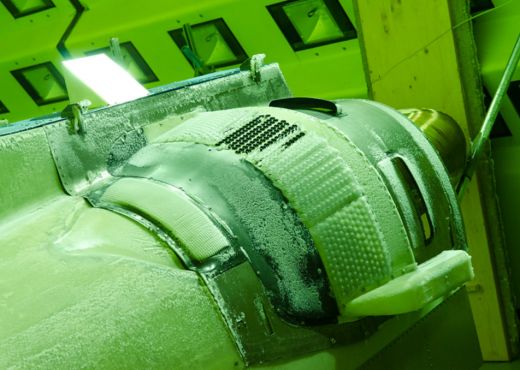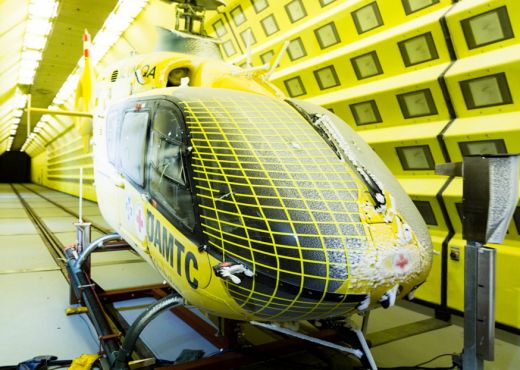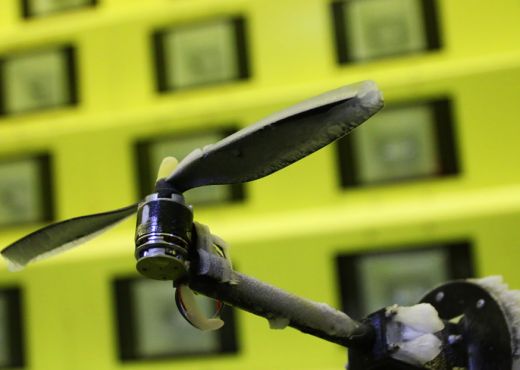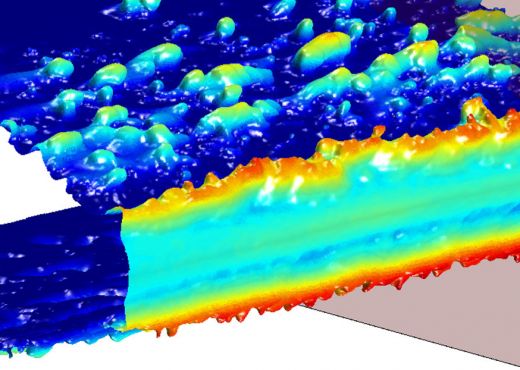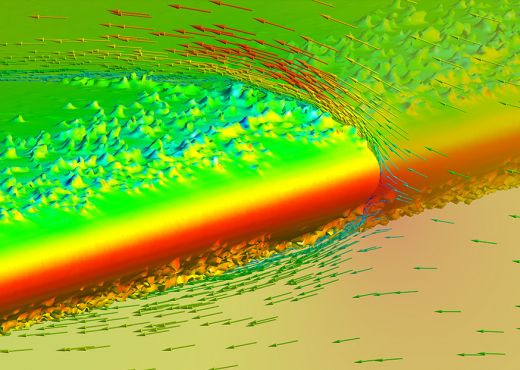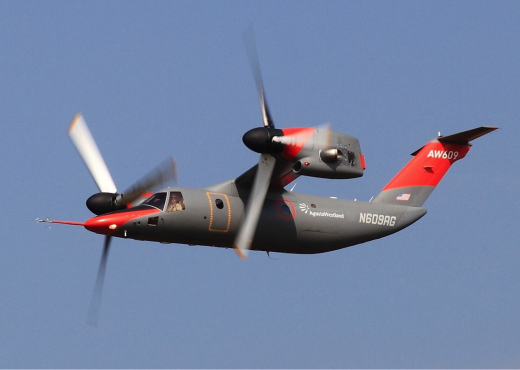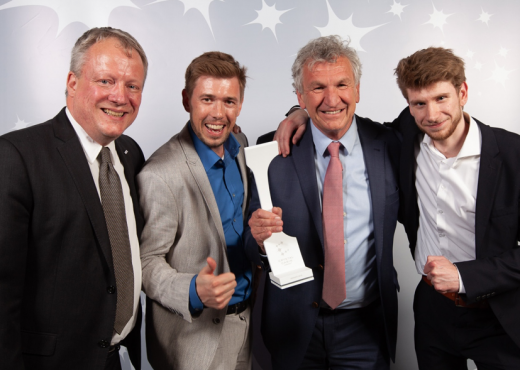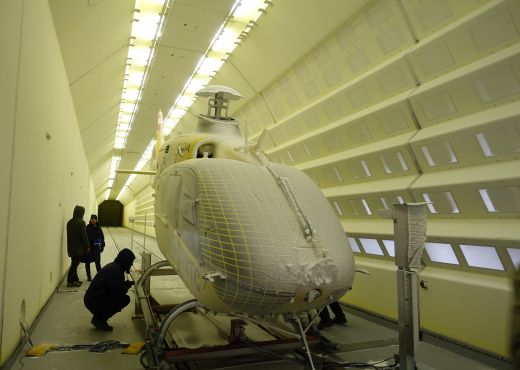How Austria Became a Technology Leader in the Field of De-Icing
The great cooperation of Austrian de-icing players in national and international research and development projects has been rewarded by outstanding results:
For instance, the icing of various full-size aircraft, such as helicopters, and smaller aircraft can be studied in the Vienna Climatic Wind Tunnel operated by the Rail Tec Arsenal; a lucrative new business field, which is now used by all well-known manufacturers. Successful R&D cooperation has led, among other things, to the founding of the Austrian Institute for Icing Sciences (AIIS), which documents certification tests in the Rail Tech Arsenal using a 3D scan and replicates complex ice structures using additive manufacturing processes. The institute is in close contact with the FH Joanneum, which has special simulation expertise, such as the development of icing codes, and important research infrastructure. By the same token, the Austrian Institute of Technology (AIT) excels on a scientific level. Here, the ice accretion on aircraft structures and its aerodynamic effect using computational fluid dynamics is researched.
The de-icing system of the Austrian company Villinger (LDI) is one of the most modern and efficient on the world market, and superior in terms of technology and underlying know-how.
Experts in anti-icing coatings based on hydrophobic or icephobic materials can be found in the AAC (Aerospace and Advanced Composites).
When it comes to ice detection sensors, eologix sensor technology is the right choice.
How important Austria has become as an international icing hotspot is further confirmed by an international de-icing expert basing its company, Aerotex, in Vienna.
With the aim of further focusing a wide range of competence fields in aviation-related icing and de-icing research in Austria, the BMK has developed the Icing Strategy for the Austrian Aviation Sector 2030+. The Strategy also supports increasing visibility and strategic position at European and international level.
The de-icing field of expertise can be encapsulated by the following Innovation Booster.
Innovation BoosterThe Climatic Wind Tunnel Takeoff
The climatic testing of aviation products is time consuming, poorly replicable and expensive. Climate wind tunnels offer the possibility of climate simulation, and are used for cold engine starting tests, icing tests and the testing of components under extreme temperatures.
In Austria, weather and thermal environment simulation are among the strengths of Rail Tec Arsenal's (RTA) Climate Wind Tunnel, the world's largest rail vehicle research infrastructure. Customer inquiries led in 2012 to the extension of this proven wind and weather simulation to the aviation industry, too. Since then, engines, helicopters and small airplanes have been tested here, including the effects of icing due to cold and humidity. In order to produce realistic clouds for certification tests in aviation, a mobile icing rig was developed, with which the large climatic wind tunnel can be converted into the world's largest icing wind tunnel. In 2014, the first certification test on a helicopter engine inlet at full throttle was carried out together with Leonardo (formerly Agusta Westland) and the European Aviation Safety Agency (EASA). In addition to icing tests, climatic tests can be carried out at wind speeds of up to 300 km/h.
Numerous pioneering developments and insights for the aircraft de-icing systems' research field have been and will be tested here.
This is unique:
- Largest icing wind tunnel for aircraft
- Testing with running engines up to 1800 HP
- Simulation of freezing rain according to EASA Certification Standards CS-25 / CS-29 Appendix O
Therein lies potential for development:
- Independent climatic wind tunnel for aviation in Austria
- First rotor test rig in Europe
- Production of near-natural artificial snow and Supercooled Large Droplets
- Research and development in the field of icing coupled with anti-icing
- Comprehensive range of services for certification tests: preparation, implementation, documentation, simulation
Flexibility is in demand – it is not the biggest one, but the quickest one that wins!
Milestones
Innovation BoosterUnderstanding the Icing Process Helps Save Money
Investigating icing effects for aircraft certification via flight tests is very costly, both timewise and moneywise. Therefore, investments are increasingly being made in ice deposits' modeling and forecasting. It is a safety-related topic that has also been included in the ACARE research agenda.
In Austria, two organisations work on icing process modeling: the focus of FH JOANNEUM Graz lies in numerical simulation and icing code development, whereas the focus of the Austrian Institute for Icing Sciences (AIIS) lies in documentation using 3D scan technologies and the corresponding evaluation. Both institutes can utilise a small icing wind tunnel at FH JOANNEUM for research purposes. The icing process is extremely complex, reacting very markedly to the smallest changes, making controlled testing and measuring procedures more difficult. It is only the currently available high computing power that enables a well-founded research and the resulting numerical simulation; it is only the support of public research funds that enables the development and implementation of a fundamental comprehension of the icing process.
This is unique:
- Test planning, documentation and simulation from a single source
- Establishment of a European validation database to improve the simulation models
- Additive manufacturing methods for the production of complex artificial ice structures
- Analysis of surface roughness of ice structures
Therein lies development potential:
- Development of icing models
- Time-resolved ice growth scans (4D scans)
- Vertical icing wind tunnel for large drops simulation
- Modeling of surface roughness
State funding is essential for the research of niches and technologies that demand a great deal of know-how.
Milestones
Innovation BoosterModern De-Icing Systems Warm Up New Markets
Conventional thermal de-icing systems consume a lot of energy, are prone to failure and often have a negative influence on the aerodynamics. What is more, thermal bleed air systems, for example, which are used in almost all conventional large aircraft are no longer applicable to new composite aircraft (e.g., Boeing 787 Dreamliner) due to heat build-up.
The company Villinger has taken up this challenge and developed an electro-thermal de-icing system, in which, among other things, self-developed electrically heatable coatings are applied. Starting with a Take Off project for the propeller de-icing, developments in wing and rotor blade de-icing soon followed, including de-icing of helicopters, aircraft in the CS23 category and UAVs with spans of up to 20 m. The developed de-icing technology leads to significantly reduced energy consumption and greater robustness. Moreover, it can be aerodynamically integrated into the structure of the aircraft, which in turn results in a reduction in fuel consumption and improved flight performance. Villinger is already certified according to EASA Part21 G (Production Organisation), and continues to conduct research and development in the European Cleansky programme or with NASA among others.
R & D projects significantly contribute to the development of this de-icing technology and yield numerous strategic partnerships.
This is unique:
- Self-regulating de-icing systems fully integrated into the structure
- Winner of the "Aviation Oscar" Crystal Cabin Award - as the first Austrian company
- First infrared-based cabin heating system
Therein lies potential for development:
- De-icing systems for large aircraft (CS 25-LPA standard)
- De-icing system for "small" helicopters, e.g. Airbus AH 145 (ÖAMTC air rescue)
- De-icing system for wind turbines
Do not give up, learn from your mistakes and look ahead!



